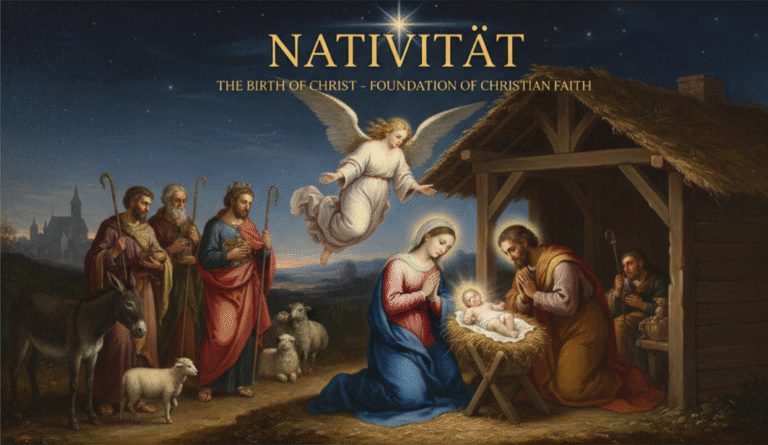The term Nativität refers to the birth of Jesus Christ, a central event in Christian faith. The story begins in Bethlehem, where Mary and Joseph welcomed Jesus in humble surroundings. Recorded in the Gospels of Matthew and Luke, the nativity story has been celebrated for centuries and remains a key part of Christmas traditions worldwide.
This historical account not only highlights the significance of Jesus’ birth but also teaches lessons of humility, love, and faith. Understanding the origins of Nativität helps readers appreciate its deep spiritual and cultural meaning, making it a cherished story across generations.
| Event | Location | Significance |
|---|---|---|
| Birth of Jesus | Bethlehem | Marks the start of Nativität |
| Visit of the Shepherds | Bethlehem fields | Represents humility and faith |
| Visit of the Wise Men | Bethlehem | Shows recognition and honor |
Cultural Significance
| Country | Tradition | Unique Feature |
|---|---|---|
| Germany | Krippe displays | Elaborate nativity scenes |
| Italy | La Befana celebrations | Holiday folklore mix |
| Mexico | Posadas | Reenactment of Mary and Joseph’s journey |
Nativität holds a special place in cultures worldwide, especially during Christmas. From festive Advent celebrations to Weihnachtslieder (Christmas carols), communities honor the birth of Jesus with unique traditions.
In many homes, Krippe (nativity scenes) featuring the Heilige Familie—Mary, Joseph, and Jesus—are displayed. These customs reflect the values of family, faith, and joy, connecting people across generations. Celebrating Nativität not only preserves history but also brings communities together, keeping the story meaningful and alive throughout the holiday season.
Nativität in Art and Literature
| Work | Artist/Author | Medium |
|---|---|---|
| Adoration of the Magi | Sandro Botticelli | Painting |
| The Nativity Story | Bible | Text |
| Nativity Scenes | Various Artists | Sculpture / Display |
Nativität has inspired countless works of art and literature over the centuries. From classical paintings to detailed Krippe displays, artists depict the Heilige Familie—Mary, Joseph, and baby Jesus—with devotion and creativity.
Famous stories and poems retell the nativity scene, highlighting its spiritual meaning and humble beginnings. These artistic expressions help people connect with the story of Jesus’ birth, making Nativität not just a religious event but also a rich source of cultural and creative inspiration worldwide.
Modern Interpretations
Today, Nativität is celebrated in both traditional and modern ways. Beyond church ceremonies, many people create creative Krippe displays or participate in festive events that highlight the Heilige Familie.
Media, films, and literature often present contemporary takes on the nativity story, connecting it to current culture. These modern interpretations keep the story relevant, allowing families and communities to explore the values of humility, love, and faith while celebrating Christmas in ways that resonate with today’s world.
Spiritual Meaning
The Nativität story carries deep spiritual lessons about faith, love, and humility. The humble birth of Jesus in Bethlehem reminds believers of the importance of simplicity and compassion. The Heilige Familie—Mary, Joseph, and Jesus—symbolizes devotion, family bonds, and trust in Christian faith.
Celebrating Nativität encourages reflection on these values, inspiring people to embrace kindness and generosity. This spiritual significance makes the nativity story timeless, touching hearts across generations and cultures during Christmas and beyond.
Also read: How Does Insetprag Improve Innovation and Practicality
Common Misconceptions
Many people misunderstand aspects of Nativität. Some confuse the biblical story with popular folklore or holiday myths, while others think it only represents a religious tradition. In reality, Nativität combines historical accounts from the Gospels of Matthew and Luke with cultural celebrations worldwide.
Understanding the true story of the Heilige Familie—Mary, Joseph, and baby Jesus—helps clear up these misconceptions. Appreciating the historical and spiritual context ensures the nativity story remains meaningful for everyone during Christmas.
Fun Facts and Trivia
| Fact | Description |
|---|---|
| Origin of Krippe | Dates back to the 13th century |
| Global Celebrations | Nativität celebrated with songs, plays, and displays |
| Art Inspiration | Inspired countless paintings, literature, and music |
Nativität has many interesting facts that make it even more fascinating. Did you know that the tradition of Krippe (nativity scenes) dates back to the 13th century? People around the world celebrate Christmas with unique customs, including Weihnachtslieder (Christmas carols) and festive plays reenacting the birth of Jesus.
The story of the Heilige Familie continues to inspire art, music, and literature. These fun facts highlight how Nativität is both a spiritual and cultural treasure cherished globally.
FAQS Nativität
What is the meaning of Nativität?
Nativität refers to the birth of Jesus Christ and its significance in Christian faith, celebrated during Christmas worldwide.
Where did the story of Nativität originate?
The story originates in Bethlehem, recorded in the Gospels of Matthew and Luke, and highlights the humble birth of Jesus.
How is Nativität celebrated around the world?
Answer: People celebrate with Krippe (nativity scenes), Weihnachtslieder (Christmas carols), church ceremonies, festive plays, and family traditions.
What is the significance of the Heilige Familie?
The Heilige Familie—Mary, Joseph, and baby Jesus—represents faith, humility, and family values central to the Nativität story.
Are there any fun facts about Nativität?
Yes! The tradition of Krippe dates back to the 13th century, and Nativität continues to inspire art, music, and cultural celebrations globally.
Conclusion
Nativität is more than a story; it is a celebration of faith, love, and family. From its historical roots in Bethlehem to modern Krippe displays, the story of the Heilige Familie inspires people worldwide.
Celebrating Christmas through Nativität traditions helps communities connect, reflect on spiritual values, and share joy across generations. Understanding its cultural and spiritual significance allows everyone to appreciate the timeless message of humility, hope, and devotion that Nativität brings.

